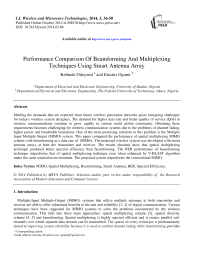Performance Comparison Of Beamforming And Multiplexing Techniques Using Smart Antenna Array
Автор: Kehinde Odeyemi, Erastus Ogunti
Журнал: International Journal of Wireless and Microwave Technologies(IJWMT) @ijwmt
Статья в выпуске: 3 Vol.4, 2014 года.
Бесплатный доступ
Meeting the demands that are expected from future wireless generation networks poses intriguing challenges for today's wireless system designers. The demand for higher data rate and better quality of service (QoS) in wireless communications continue to grow rapidly in current world global community. Obtaining these requirements becomes challenging for wireless communication systems due to the problems of channel fading, higher power and bandwidth limitations. One of the most promising solutions to this problem is the Multiple Input Multiple Output (MIMO) system. This paper compared the performance of spatial multiplexing MIMO scheme with beamforming at a data rate of 100Mb/s. The proposed wireless system was developed with smart antenna arrays at both the transmitter and receiver. The results obtained show that spatial multiplexing technique produced better spectral efficiency than beamforming. The BER performance of beamforming technique outperforms that of spatial multiplexing technique even when enhanced by V-BLAST algorithm under the same simulation environment. The proposed system outperforms the conventional MIMO.
MIMO, Spatial Multiplexing, Beamforming, Smart Antenna, BER, Spectral Efficiency
Короткий адрес: https://sciup.org/15012871
IDR: 15012871
Текст научной статьи Performance Comparison Of Beamforming And Multiplexing Techniques Using Smart Antenna Array
Multiple-Input Multiple-Output (MIMO) systems that utilize multiple antennas at both transmitter and receiver are able to offer substantial benefits to the rate and reliability [1, 2] of digital communication. Various techniques have been suggested for MIMO systems to solve the problems encountered by the wireless communication. This falls into three main approaches: spatial multiplexing scheme [3], spatial diversity scheme [4, 5] and beamforming. Spatial multiplexing is highly spectral efficient and it creates parallel subchannels over which separate data streams can be transmitted. The spatial diversity technique is predominantly aimed at improving system reliability because it is used to combat channel fading while beamforming provides
* Corresponding author.
a significant increase in performance of wireless communication systems by focusing on the signal energy in a particular direction to increase the received SNR and also to reduce interference [6].
Smart antenna arrays have gained much attention in the past few years for its ability to significantly increase the wireless communication systems performance, in terms of spectrum efficiency and reliable operation. Smart antenna utilizes strong spatial correlation to process the received signal by antenna arrays with beamforming technique. Also, it is able to provide high directional beamforming gain and reduce the interference from other direction under high spatial correlated MIMO channel. Under smart antenna configuration, the antennas spacing is small and it is usually assumed to be half wavelength [7].
In a conventional wireless communication system, there is only one antenna at the transmitter and one antenna at the receiver. This system which is called the Single-Input Single-Output (SISO) antenna system suffers a bottleneck in terms of capacity due to the Shannon-Nyquist criterion [8, 9]. Current wireless services demand much higher data bit-rate transmission with smaller bit error rate. In order to increase the capacity of the SISO systems to meet the increase demand, the bandwidth and transmission power have to be increased significantly. As the bandwidth and power are scarce or limited resources, techniques which lead to efficient utilization of these resources are quite necessary. There are several ways to increase the bit rate of a wireless communication system, these include choosing a shorter symbol duration T which results into a bandwidth expansion and is typically undesired. This is because; a larger fraction of the frequency spectrum will be occupied, since the required system bandwidth is determined by the symbol rate, 1/T. Moreover, wireless channels are typically characterized by multipath signal propagation caused by reflections, scattering, and diffraction [10]. Shorter symbol duration can therefore cause an increased degree of inter-symbol interference which may lead to a loss in error performance. Another means of increasing the bit rate is the use of a multicarrier approach [10] by multiplexing data symbols onto multiple narrow sub-bands, which reduced the problem of Inter-Symbol Interference (ISI), but still lead to increase in the system bandwidth requirement. The bit rate can also be enhanced by using higher-order modulation schemes; transmitting more than one bit per data symbol [8], which results in a higher bit rate without bandwidth expansion. However, the error performance will again deteriorate by given the same average transmit power per bit. Finally, one can employ sophisticated source-coding techniques [12], to compress the information sequence before transmission, unfortunately an excessive compression rate will cause signal distortions.
In this paper, the MIMO technique with Smart antenna arrays is conceived as a promising solution for spectrally efficient transmission technique for wireless communication system. This could increase the system capacity with lower bit error rate substantially without increasing the transmission power and bandwidth [2]. The comparison between the performances of spatial multiplexing MIMO scheme and beamforming technique for high data rate wireless communication system is presented. Spectral efficiency and bit error rate were the two performances metric employed for the comparison of the two techniques.
-
2. System Model and Analysis
Each of the schemes was applied to the proposed wireless system which was equipped with Smart antenna array at both the transmitter and receiver as illustrated in figure 1 (a) and (b). The system was configured in such a way that both the transmitter and the receiver have one or more smart antenna arrays with the transmitter having MT antenna arrays with each array having N antenna elements and there are MR antenna arrays at the receiver with each array having K antenna elements. We assumed that the channel has the Rayleigh fading distribution and spatially uncorrelated complex Gaussian noise was assumed to be added to the faded signal at the receiver. The spacing between the antenna arrays was made to be more than 10λ while the antenna element spacing of each antenna array is a half wavelength (λ/2).
When considering beamforming technique for the system as in fig. 1 (a), the data at the transmitter was applied directly to the antenna and beamforming vector was then weighted on the data before transmission. The vectors W and Z are called the transmit beamforming and receive beamforming vectors, respectively. In case of spatial multiplexing, the data was splitted at the transmitter and each of the data was transmitted to each antenna array as shown in fig. 1 (b).
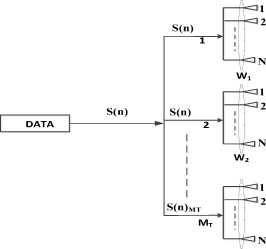
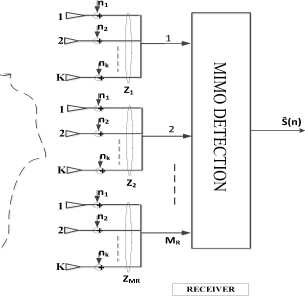
-
(a) Beamforming Scheme
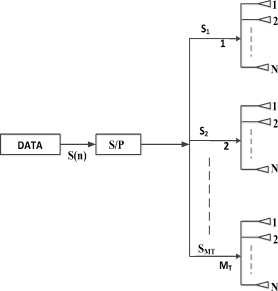
TRANSMITTER
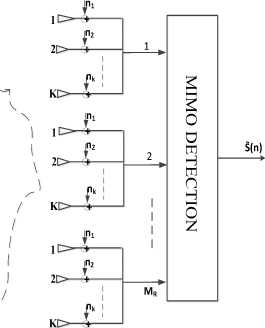
RECEIVER
-
(b) Spatial Multiplexing Scheme
-
Fi g.1: Proposed Wireless System with Smart Antenna Array
-
3. System Analysis
Generally, Conventional MIMO systems with M transmit antennas and M receive antennas have a channel impulse response given as [13]:
h11 h12
h 1 M T h 2 M T
h 21 h 22
h h
У 2 2R 1 M R 2 2
hMRMT ,
-
2 T M 2 2 x M i
where h ( т ) shows the channel impulse response between the jth transmitter to the ith receiver element and is given as:
L
hi, j(т) = Ха5(г -тп) n=1
where h ^т) is the multipath channel impulse response, L is the number of paths, a shows the amplitude of the n th path and it obeys independent and identical Rayleigh distribution (i.i.d), 5 ( . ) represents the impulse function and т represents the delay of the n th arriving path.
Relating this to multiple antenna arrays case as in fig. 1, this makes the channel matrix, H, to become a KMR x NMT matrix. RT
V Mr Mr Mr J KMR x NMT where h1 is channel fading vector from jt antenna array at the transmitter to ith antenna array at the receiver.
hj =
h ij ,,11
hj ,2
h ji ,,1 N
h j ,1
i ,2
hj ,2 i ,2
j , N h i ,2
h j ,1 i , K
h j ,2
h jN
I , K
J K x N
-
3.1 Analysis of Spatial Multiplexing Technique
At the transmitter, the transmit signal is divided into M T parallel signals S ( n ), S ( n ) S ( n ) through the splitter (demultiplexer) and is sent to the different antenna array, thus the transmit signal becomes N x 1 vector as:
Thus, the transmit signal after transmission becomes:
Xj( n) = HSj( n)(6)
At the receiver, the received signal at each i th antenna array when noise is added is obtained as:
ri (n) = Xj (n) + n (n)
According to eq. (6), received signal becomes:
r; (n) = HS, (n) + n( n)
where П ( n ) spatially uncorrelated complex Gaussian noise with entry is distributed as ~CN (0, No ).
Therefore, according to (4), the received signal can be further expressed as:
r , ( n ) = ^ h j ( n ) S j ( n ) + n ( n ) j = 1
r i ( n ) = h 1 ( n ) S j ( n ) +.........+ h M ( n ) Smt ( n ) + n , ( n ) (10)
In matrix form:
r 1
r 2
r M R
h 1 1 h 1 2 h 1 h 2
h M 1 R h M 2
hMT hMT
Then, the received signal can be recovered as:
r = H'S + n
-
3.2 Analysis of Beamforming Technique
When beamforming is applied to the system, the transmit signal S ( n ) at the transmitter is sent through the antenna array to perform beamforming (transmit beamforming) and the signal becomes:
S j ( n ) = W j S ( n ) (13)
where W is the transmit beamforming weight vector and is given as:
W , =[ a , ( в , ) ] ' (14)
//-х X I~1 — j2ndtSin9. 7 X,.
ат (9j) = ^1, e t j
,e
- j 2 n ( N - 1) d t Sin Q j I X
T
where 9 is the angle of departure (AOD), d is the distance between the antenna element at j t transmitter antenna array, X is the carrier wavelength, N is the number of element at the jtth transmitter antenna array and aT ( 9 ) is the transmit array steering response. After beamforming, S ( n ) becomes N x 1 column vector S j ( n ) which is then transmitted via the channel.
At the receiver side, the receive signal at i t array element is denoted as vector x ( n ) and is given as:
X ,( n ) = HW,S ( n )
The receive beamforming is then weighted on x ( n ) and the output signal after beam forming at the i th receive element antenna array is given as:
NMT ri(t) = S ZH ( Xj (n) + gi(n) ) j=1
NM
r(t) =^ ZHHSj(n) + ZHgt(n) (18)
.j = 1
where Z is the received beamforming weight vector and is given as:
Z = [ a^,] (19)
ак (9) = 1, e
(- j 2 n d r Sin 9 j I 2 ,.
- j 2 n ( K - 1) drSin 9 i I X
where 9 is the AOA (Angle of Arrival), d is the distance between the antenna element at i h transmitter array, X is the carrier wavelength, K is the number of element at the i t1 receiver antenna array and aR ( 9 ) is the receive array steering response.
NMT
r(n) = S ZiHHSj(n)+Пт(n) j=1
where % ( n ) spatially uncorrelated complex Gaussian noise with entry is distributed as ~CN (0, No ) and is given as:
n-(n) = ZH gi(n)
Since, S j ( n ) = WjSj ( n ) we then substitute for S j ( n ) in (21).
ri (t) = Z^( n ) W ^( n) +.........+ZHhMT (n )WMt SMt (n)+щ (n)
In matrix form:
|
[ r 1 ’ 2 |
= |
" Z1Hh 1 1 W Z H h W 2 |
Z 1 Hh 1 2 W 2....... ZHh 2 W ....... |
Z H h MT WM " 1 1 M T . Z H h MT WM 22 M T |
Г S .( n ) 1 S 2 ( n ) |
+ |
Г п П 2 |
(24) |
|
_ M _ |
7H z,1 w Z M R h M R W 1 |
ZH h 2 W ..... M R M R 2 |
7H M^tw '.. Z M RhMR W M T |
Sm t ( n ) |
]1M t _ |
r = HS + n (25)
where H is an effective channel matrix and is defined as:
Z 1 Hh 1 1 W 1 Z 1 Hh 1 2 W 2....... Z 1 Hh 1 MTW M T
Z 2 Hh 2 1 W 2 Z 2 Hh 2 2 W 2........ Z 2 Hh 2 MTW M T
ZH h 1 W ZH h 2 W ........ ZH hMTW
RR RR RR T
This shows that the channel matrix consists of MIMO channel fading and information concerning AOD and AOA. As a result, H is then transformed from a KM D x NM^ channel matrix to a M D x M , channel matrix H.
RT RT
Due to the strong spatial correlation existing in each antenna array, according to the fading of the first element for each antenna array, the entire steering response of the antenna array is [14]:
L - 1
i = 0
where the channel fading vector h / is a matrix of K x N according to eq. (4), p ( t ) is the multipath fading components, coupling the first element of the j th antenna array at the transmitter to the i th antenna array at the receiver and it obeys independent and identically Rayleigh-distribution (i.i.d).
Since the channel is assumed to be flat, (27) becomes:
hi (t) = [ aReP,/ t)[ a.e"
Then, the effective channel fading element H can be roughly obtained as:
Hi, j = [ aRe ]H [ aRe^, j [ aT6j ]T [ ат93 ]*
Since ^aR^| = Kk and ^aT0у|| = NV where . is the Euclidean Vector Norm, thus the effective channel fading element H can be approximately obtained as:
Hi.j= KN в(30)
Therefore, the corresponding entire channel matrix can be formed as:
|
" в 1,1 |
в 1.2 ... |
.... в 1. M T |
||
|
H = KN . |
в и |
в 1.1 ... |
.... в 2. M T |
(31) |
|
_ P mMR .1 |
P mr .2 ... |
.... ...... .... Pmr . M T J |
Since the element of в j and ht . has the same distribution (i.i.d). then the effective channel matrix in eq. (26) becomes:
H = KN. H(32)
Thus, the receive signal is:
r (n) = HS + n(33)
-
3.3 Detection of the Transmitted Signal by each Technique
In the case of spatial multiplexing. to detect the transmit signal s ( n ) . Zero forcing (ZF) and Minimum Mean Square Error (MMSE) detection algorithm were considered and the receiver was designed using the linear matrix G algorithm. Thus, according to (12) the receive signal was obtained as:
r = HS + n (34)
Then the detected signal is
S = Gr
S = GHS + Gn
For ZF detection algorithm:
G zf = ( H H H ) - 1 H H
For MMSE detection algorithm:
G mmse = [ H H H +— Г1 H H
Y o
If the system uses ZF or MMSE detection algorithm, the effective detection SNR of the q th data streams with linear ZF or MMSE equalizer at the receiver is expressed as [15, 8]:
- ZF = ■ Yo .
q ( HHH ) qlq
; q = 1,2,..........MT
MMSE
Y
Y o
[ HHH +
I KMR Y o
q , q
-1
; q = 1,2,..........MT
where Yo is the average SNR at each receiver i t antenna array and is obtained as:
P q
Yo KNo where P is the transmit power at each jth transmit antenna array.
Since the Channel State Information is known at the receiver only, then, the transmit power is equally allocated across the transmit antenna array and is obtained as,
P = P^-q MN
Then, the eq. (41) becomes:
Yo =
P o
M KNN
where P is the total transmitted power.
By substituting for Yo in (39) and (40), then the effective SNR
ZF
Y q
P o
( H H H ) 1 KNNoMT q , q T
; q = 1,2,
. M
MMSE
Y q
P o
MTKNN [ H H H + I' M ]
To
L Y o
I-1 q , q
In case of beamforming scheme, the received signal is obtained according to (33) and the received signal is then detected as:
s ( n ) = 4£ KNS ( n) + < n )
where . Я is the maximum positive eigenvalue of the transmitted signal.
Thus, the effective detection SNR for the beamforming technique is obtained as:
YB = Yo (HHH)
where Yo is the average SNR.
According to (41), the effective SNR becomes:
YB/ = yK2 N 2(HHH )
Since beamforming utilizes only the strongest sub-channel and allocate all power to it, effective SNR then becomes:
YB/ = K2 N 2YoAmax
In order to accomplish the use of only the best channel, transmitter choose to allocate all its power to the best channel and no power to the remaining links, thus, the average SNR at the receiver is obtained as:
Y = o KNo
Since the total transmitted power is allocated, then p = p , the average SNR becomes:
P o
Y o KN o
Substitute for average SNR in (49), the effective SNR is obtained as:
Г.В = KN 2 P o ^ max
N o
The system capacity for wireless system according to Shannon is given by [6, 8]:
NMT
C =£ log2(1 + Yq ) (53)
q = 1
The system capacity for the proposed system when spatial multiplexing is applied is obtained as:
NMT

o
(H H Г MTKNN k , k To
CZF = ^ l0g2
k = 1
( A
The system capacity for the proposed system when the beamforming technique is applied is obtained as:
C f = l0g 2 (1 + KNP oM ( 56 )
-
4. Simulation Results and Discussion
It is the position of this work that maximum spectral efficiency and low bit error rate can be achievable by increasing the number of elements in each antenna array at both ends of the radio link. The simulation results of the spatial multiplexing and beamforming technique for the proposed high data rate wireless communication system are therefore presented. The performance metrics in terms of spectral efficiency and BER of conventional MIMO are given to compare with the two proposed model. Spectral efficiency is the capacity of the system which shows the amount of maximum information that can be sent by a wireless communication system. Conventionally, this can be increased by the factor of min { MR, MT } without using additional transmits power or spectral bandwidth. In this paper, over one million message lengths were sent from the transmitter over the communication channel at the rate of 100Mb/s. Each of the symbol was modulated and demodulated with the aid of 16-QAM. The transmitter and the receiver were assumed to have 4 smart antenna arrays at both ends and we examine N and K to be equal to 2 and 4 elements in each array. The spacing between antenna arrays is larger than 10λ, while the spacing between antenna elements is λ/2. The channel has the Rayleigh fading distribution, and spatially uncorrelated complex Gaussian noise is added to the faded signal at the receiver. In the case of beamforming technique, the angle spread at each of the transmitter antenna array is 30 degrees and 70 degrees at the receiver side. ZF and MMSE detection were adopted at the receiver when spatial multiplexing technique was applied. These detections were further enhanced by linear nulling and successive interference cancellation algorithm called Vertical- Bell-Laboratory Layered Space-Time Architecture (V-BLAST) to achieve better performance.
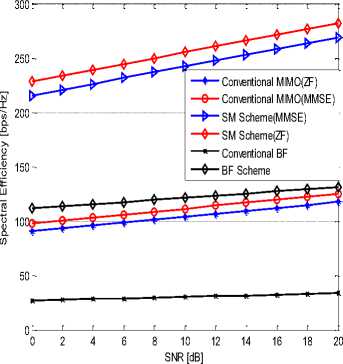
Fig. 2: Spectral Efficiency for the Proposed Wireless MIMO System when , , K=2 and N=2
T R
Fig. 2 shows the spectral efficiency performance of the proposed system when spatial multiplexing (SM) and beamforming (BF) techniques were applied. This result indicates that the spatial multiplexing technique has the best performance with average spectral efficiency of 252.77b/s/Hz and 241.04b/s/Hz for MMSE and ZF detection respectively when compared with beam forming scheme with the average spectral efficiency of 121.39b/s/Hz. The result further shows that conventional MIMO system when M = 2 and M = 2 has an average spectral efficiency of 111.37b/s/Hz when MMSE detection was used and 104.17b/s/Hz when ZF detection was used, which shows that the conventional MIMO system has a poor capacity performance when compared to the other schemes.

Fig. 3: BER performance when M = 2 , M = 2 , N=2 and K=2 T R
Fig. 3 shows the average error produce by the proposed system when M = 2 , M = 2, K=2 and N=2. It is clear that MMSE detection performed better than the ZF detection in the entire scheme. The result shows that spatial multiplexing scheme performs better at lower SNR while beamforming scheme perform better at high SNR. Spatial multiplexing scheme provided an average error of 0.0158 for MMSE detection and 0.0363 for ZF detection, but the beamforming technique provided a higher average error of 0.0025. The performance of the system was further enhanced by V-BLAST algorithm. V-BLAST improves the performance of MMSE and ZF detection in the entire schemes. Spatial multiplexing outperforms other schemes with MMSE detection having a better average BER of 0.0012 and ZF detection with an average BER of 0.0013 when compared with beamforming. This proves that V-BLAST has improved the system performance in terms of error reduction by 38.9% and 46.6% for MMSE and ZF detection respectively.
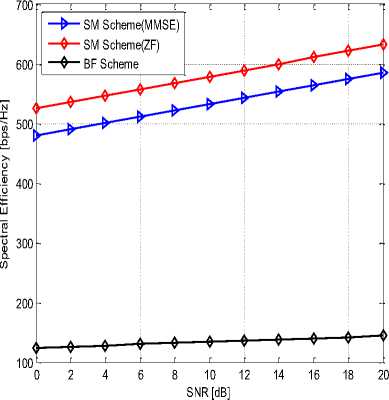
Fig. 4: Spectral Efficiency for the Proposed Wireless MIMO System when M = 4 , M = 4 , K=4 and N=4
Fig. 4 shows that the spectral efficiency of the system increases linearly with the number of elements in each antenna array. With the M and M antenna arrays remaining constant and the elements K and N increased from two to four, the simulation result shows that the capacity performance of spatial multiplexing is better than that of beamforming technique. SM provides an average spectral efficiency of 578.72b/s/Hz when MMSE detection was used and 532.44b/s/Hz when ZF detection was used, while the beamforming technique produces an average spectral efficiency of 133.94b/s/Hz. This shows that spatial multiplexing scheme has an increment in average spectral efficiency of about 325.95b/s/Hz for MMSE detection and 291.40b/s/Hz for ZF detection confirming that the capacity of MIMO system can be enhanced by increasing the number of antenna element in each array at the transmitter and receiver.
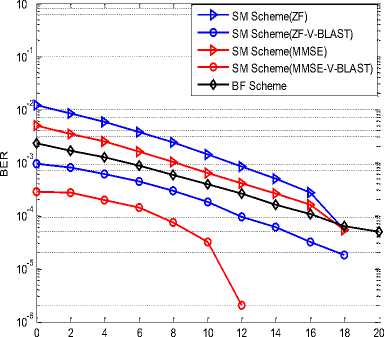
SNR [dB]
Fig. 5: BER performance when M = 2 , M = 2 N=4 and K=4 ,
Similarly, fig. 5 shows the BER performance of the system; when N and K were increased from 2 to 4 while the antenna array M and M remain constant. The result proves that the increase in the antenna array element N and K produced better system performance. It was shown that BF scheme with 0.00069 average errors has a better BER performance than SM scheme with average error of 0.0014 for MMSE detection and 0.0032 for ZF detection. This indicates a significant improvement in BER compare to when N and K equal to 2 but the SM scheme was enhanced with V-BLAST to achieve better performance.
-
5. Conclusion
The performance comparison between beamforming and spatial multiplexing technique was carried out for a high data rate wireless communication system. The MMSE and ZF MIMO detection algorithm was employed at the receiver and was further enhanced by V-BLAST. Spectral efficiency and BER were the two performance metrics used to determine the efficiency of the techniques. The simulation results show that the spatial multiplexing outperforms the beamforming scheme in spectral efficiency but it produces higher bit error rate than the beamforming scheme. However, the proposed system has better performance than the conventional MIMO system. It was found that the higher the antenna array elements, the higher the system spectral efficiency and the better the system reliability for both techniques. The results also show that the MMSE detection has a better performance than the ZF detection for the spatial multiplexing technique and even when enhanced by V-BLAST.
-
[1] Proakis J. G., (2001), “Digital Communications”, 4th ed. New York: McGraw-Hill, 2001.
-
[2] Shannon C. E., (1948) “A mathematical theory of communication – Part I & II,” Bell Syst. Tech. J., vol. 27, pp. 379–423
-
[3] Steele R., (1994), “Mobile Radio Communications” New York: IEEE Press, 1994.
-
[4] Hanzo L., Muenster M., B. Choi J., and Kelle T. (2003), “OFDM and MC-CDMA for Broadband MultiUser Communications, WLANs and Broadcasting” Chichester: John Wiley & Sons / IEEE Press.
-
[5] Telatar I. E., (1999), “Capacity of multi-antenna gaussian channels”, Europ. Trans. on Telecom., vol. 10,.
-
[6] V. Tarokh, N. Seshadri, and A. Calderbank, “Space-time codes for high data rate wireless communication: performance criterion and code construction,” IEEE Transactions on Information Theory, vol. 44, no. 2, pp. 744-765, Mar. 1998.
-
[7] Ian F. A, David M. G, and Elias C. R., (2010), “The evolution to 4G cellular systems: LTE-Advanced”, Elsevier journal of Physical Communication, Vol. 3, pp. 217–244.
-
[8] Fochini G, and Gans M., (1998) “On limits of wireless communications in a fading environment when using.
-
[9] Gregory G. Raleigh, John M. Cioffi, (1998), “Spatio-temporal coding for wireless communication”, IEEE
Trans. Commun., Volume: 46, Issue: 3, pp, 357 - 366.
-
[10] Tarokh, V.; Jafarkhani, H.; Calderbank, A.R., “Space-time block codes from orthogonal designs”, IEEE Trans. Inf. Theory, Volume: 45 Issue: 5, July 1999, Page(s): 1456 -1467.
-
[11] S.M. Alamouti, “A simple transmit diversity technique for wireless communications”, Selected Areas in Communications, IEEE Journal on, Volume: 16, Issue: 8, Oct. 1998.
-
[12] Jan M., Robert S., Lutz L., Wolfgang H. G., and Peter A. H., (2009), “Multiple-Antenna Techniques for Wireless Communications – A Comprehensive Literature Survey”, IEEE Communications Surveys & Tutorials, Vol. 11, No. 2, pp.87-105.
-
[13] Cover T. M. and Thomas J. A., (1991) “Elements of Information Theory” New York: John Wiley & Sons.
-
[14] Gore D., Health Jr. R.w., and Paularj A.; (2002), “Transmit Selection in spatial Multiplexing system”, IEEE communication Letter Vol.6, NO. 11,pp. 491-493.
-
[15] Akbar M.S., (2002), “Deconstructing Multiantenna Fading Channels”, IEEE Transactions On Signal Processing, Vol. 50, NO. 10.
-
[16] Aris L. M., Raj Kumar K. and Giuseppe C., (2009) “Performance of MMSE MIMO Receivers: A Large N Analysis for Correlated Channels”, IEEE Vehicular Technology Conference, pp.1-5.
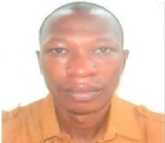
Kehinde Odeyemi received B.Tech degree in Electrical and Electronic Engineering from Ladoke Akintola University of Technology, Ogbomosho Oyo State, Nigeria, in 2008. He also received M.Eng degree in Electrical and Electronic Engineering from Federal University of Technology, Akure, Nigeria, in 2012 and currently a Ph.D. student in the same university; working on hybridization of MIMO techniques for high data rate wireless communication system. From 2012 till date, he is a Lecturer in the Department of Electrical and Electronics Engineering, Faculty of Technology, University of Ibadan, Nigeria. His research interests include communication theory, information theory, statistical signal processing, multiple-antenna systems, and CDMA and OFDM systems.

Erastus Ogunti received the B.Sc. degree in Computer Engineering in 2004 and the Ph.D. in Electrical Engineering in 2008 from the Florida Agricultural and Mechanical University, Tallahassee, Florida, USA. He is currently a Senior Lecturer in the Department of Electrical and Electronics Engineering, The Federal University of Technology, Akure, Nigeria. His research areas include micro-electro-mechanical switches, digital communications and low power integrated circuit electronics.
Список литературы Performance Comparison Of Beamforming And Multiplexing Techniques Using Smart Antenna Array
- Proakis J. G., (2001), "Digital Communications", 4th ed. New York: McGraw-Hill, 2001.
- Shannon C. E., (1948) "A mathematical theory of communication – Part I & II," Bell Syst. Tech. J., vol. 27, pp. 379–423
- Steele R., (1994), "Mobile Radio Communications" New York: IEEE Press, 1994.
- Hanzo L., Muenster M., B. Choi J., and Kelle T. (2003), "OFDM and MC-CDMA for Broadband Multi-User Communications, WLANs and Broadcasting" Chichester: John Wiley & Sons / IEEE Press.
- Telatar I. E., (1999), "Capacity of multi-antenna gaussian channels", Europ. Trans. on Telecom., vol. 10,.
- V. Tarokh, N. Seshadri, and A. Calderbank, "Space-time codes for high data rate wireless communication: performance criterion and code construction," IEEE Transactions on Information Theory, vol. 44, no. 2, pp. 744-765, Mar. 1998.
- Ian F. A, David M. G, and Elias C. R., (2010), "The evolution to 4G cellular systems: LTE-Advanced", Elsevier journal of Physical Communication, Vol. 3, pp. 217–244
- Fochini G, and Gans M., (1998) "On limits of wireless communications in a fading environment when using.
- Gregory G. Raleigh, John M. Cioffi, (1998), "Spatio-temporal coding for wireless communication", IEEE Trans. Commun., Volume: 46, Issue: 3, pp, 357 - 366.
- Tarokh, V.; Jafarkhani, H.; Calderbank, A.R., "Space-time block codes from orthogonal designs", IEEE Trans. Inf. Theory, Volume: 45 Issue: 5 ,July 1999, Page(s): 1456 -1467.
- S.M. Alamouti, "A simple transmit diversity technique for wireless communications", Selected Areas in Communications, IEEE Journal on, Volume: 16, Issue: 8, Oct. 1998.
- Jan M., Robert S., Lutz L., Wolfgang H. G., and Peter A. H., (2009), "Multiple-Antenna Techniques for Wireless Communications – A Comprehensive Literature Survey", IEEE Communications Surveys & Tutorials, Vol. 11, No. 2, pp.87-105.
- Cover T. M. and Thomas J. A., (1991) "Elements of Information Theory" New York: John Wiley & Sons.
- Gore D., Health Jr. R.w., and Paularj A.; (2002), "Transmit Selection in spatial Multiplexing system", IEEE communication Letter Vol.6, NO. 11,pp. 491-493.
- Akbar M.S., (2002), "Deconstructing Multiantenna Fading Channels", IEEE Transactions On Signal Processing, Vol. 50, NO. 10.
- Aris L. M., Raj Kumar K. and Giuseppe C., (2009) "Performance of MMSE MIMO Receivers: A Large N Analysis for Correlated Channels", IEEE Vehicular Technology Conference, pp.1-5.

